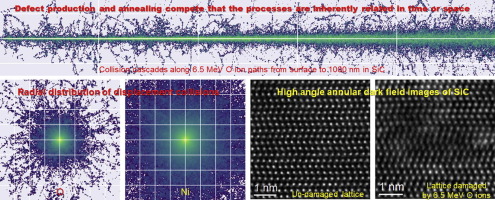Current Opinion in Solid State & Materials Science ( IF 12.2 ) Pub Date : 2017-10-16 , DOI: 10.1016/j.cossms.2017.09.003 Yanwen Zhang , Haizhou Xue , Eva Zarkadoula , Ritesh Sachan , Christopher Ostrouchov , Peng Liu , Xue-lin Wang , Shuo Zhang , Tie Shan Wang , William J. Weber

|
Understanding energy dissipation processes in electronic/atomic subsystems and subsequent non-equilibrium defect evolution is a long-standing challenge in materials science. In the intermediate energy regime, energetic particles simultaneously deposit a significant amount of energy to both electronic and atomic subsystems of silicon carbide (SiC). Here we show that defect evolution in SiC closely depends on the electronic-to-nuclear energy loss ratio (Se/Sn), nuclear stopping powers (dE/dxnucl), electronic stopping powers (dE/dxele), and the temporal and spatial coupling of electronic and atomic subsystem for energy dissipation. The integrated experiments and simulations reveal that: (1) increasing Se/Sn slows damage accumulation; (2) the transient temperatures during the ionization-induced thermal spike increase with dE/dxele, which causes efficient damage annealing along the ion trajectory; and (3) for more condensed displacement damage within the thermal spike, damage production is suppressed due to the coupled electronic and atomic dynamics. Ionization effects are expected to be more significant in materials with covalent/ionic bonding involving predominantly well-localized electrons. Insights into the complex electronic and atomic correlations may pave the way to better control and predict SiC response to extreme energy deposition.
中文翻译:

电子和原子耦合效应对离子辐照下碳化硅缺陷演化的影响
了解电子/原子子系统中的能量耗散过程以及随后的非平衡缺陷演化是材料科学领域的一项长期挑战。在中间能级中,高能粒子同时将大量能量沉积到碳化硅(SiC)的电子和原子子系统中。在这里,我们表明SiC中的缺陷演变密切取决于电子与核能的损耗比(S e / S n),核阻止能力(dE / dx nucl),电子阻止能力(dE / dx ele)),以及电子和原子子系统的时空耦合,以实现能量消散。综合实验和仿真表明:(1)增加S e / S n减慢了损伤积累;(2)电离引起的热尖峰期间的瞬态温度随dE / dx ele的增加而增加,导致沿离子轨迹的有效损伤退火;(3)为了在热尖峰内产生更紧凑的位移损伤,由于电子和原子动力学的耦合,损伤的产生受到抑制。在具有共价键/离子键的材料中,主要涉及局部电子,电离作用预计会更加显着。深入了解复杂的电子和原子相关性可能为更好地控制和预测SiC对极端能量沉积的反应铺平道路。









































 京公网安备 11010802027423号
京公网安备 11010802027423号